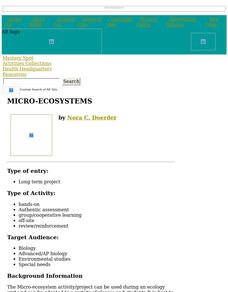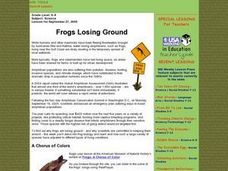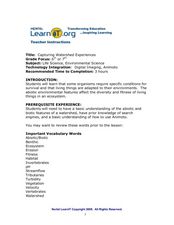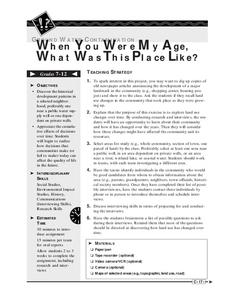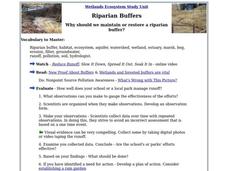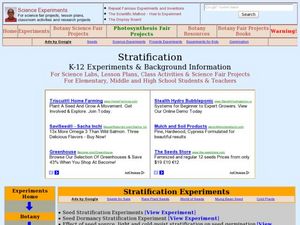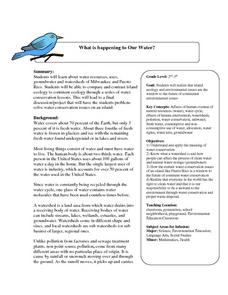Curated OER
Beetle Collection and Release
Students investigate plants and compare them to the purple loose strife. As they observe the plants they predict possible impacts on plant populations based on their observations. They work in groups and present their findings to the class.
Curated OER
Taking Action
Students use the net they make to dip macroinvertebrates at or below the surface. The flat side of the net allows pressure on the substrate so that organisms do not escape under the net. Two students hold onto the handles and submerge...
Curated OER
We Really Dig Archeology and Palentology
Sixth graders examine the differences between archeology and paleontology. Using the internet, they explore the tools and techniques used in each field. They must use the correct tools to uncover and record the objects they find. They...
Curated OER
Parasite Development and Life Cycle
If you are new to teaching agriculture classes, this outline may be helpful when you are preparing a lecture on parasites in livestock. In addition to lecturing on this topic, the lesson plan suggests that learners research the life...
Curated OER
Class Field Guide to the Sloughs
Students explore how to use field guides to identify wildlife. In this nature lesson students construct their own plant field guide.
Curated OER
Micro-Ecosystems
Students create a sustainable, self-contained ecosystem in a ten-gallon aquarium.
Curated OER
Mammal Morphology - Bats, People, and Other
In this physical characteristics worksheet, students compare bats and humans by putting a + sign in the chart for whether or not bats and humans have the same characteristics. Students do this for 17 characteristics and answer 3 questions.
Curated OER
Boston Harbor Cruise: A Shoreline Survey
The students take a harbor cruise, photograph, and draw shore line features attending to evidence of human impact/consequences, and its cost on marine/land animal habitats vegetation, weather patterns, signs of erosion, and the water...
Curated OER
Frogs Losing Ground
Middle schoolers explore an exhibit through an interactive program on frogs. They can listen to the different sounds frogs make and the different types of frogs. They search for the types of frogs they find in their local area.
Alabama Learning Exchange
Scrapping the Biomes
Fifth graders investigate biomes of the earth. In this biomes lesson, 5th graders explore eight different biomes which include the tropical rain forest, deciduous forest, grasslands, and taiga. They design an artistic scrapbook that...
Curated OER
Capturing Watershed Experiences
Young scholars observe organisms found in the water. In this lesson plan on organisms, students collect water from local streams and tributaries in order to study the organisms found in the water. As a culminating activity, young...
Curated OER
When You Were My Age, What Was This Place Like?
Students discover how land use in their community has changed. In this community and ecology lesson, students scan old newspapers to find articles about the development of community land. Students discuss and predict how land use has...
Curated OER
Watershed Tourist
Learners recognize and categorize different bodies of water. In this watershed and water environments lesson, students "Follow the Water from Brook to Ocean." Learners define the different bodies of water and sort from smallest to...
Curated OER
Goals, Interactions and Outcomes
Students recognize both sides of a dilemma through use of a Human Interaction Outline. In this Goals, Interactions and Outcome lesson, students create a diagram to show opposing views of fishermen and oil companies. Students...
Curated OER
Develop a Bird Feeder Watch List
Students explore biology by identifying animals on their school ground. In this bird species lesson, students create and utilize a simple bird feeder to attract birds near their classroom at which point they observe the color, size and...
Curated OER
Riparian Buffers
In this riparian buffer worksheet, learners click on the links to learn about why we should maintain the riparian buffer and answer short answer questions about it. Students answer 7 questions.
Curated OER
Prairies
students make booklets about each of the following: reptiles, birds, plants, animals and buffalo. Each was information and contained the facts covered in class. they research one specific area in which they were especially interested....
Curated OER
Investigating Fresh Water Ecosystems
Sixth graders examine the fresh water ecosystems. In this environmental lesson, 6th graders work in groups to collect information about a fresh water ecosystem and report their findings to the class in the form of a brochure.
Curated OER
Stratification
Students study the process of stratification and seed dormancy. In this germination lesson students prepare a medium in which to grow seeds.
Curated OER
What is Happening to Our Water?
Learners compare and contrast Wisconsin's water resources to that of Puerto Rico. They research books about islands, particularly the Puerto Rican islands. Student view illustrations of island ecology. They discuss the illustrations and...
Curated OER
What the Tijuana Estuary Does For You
Pupils discover what the estuaries do for the environment. In pairs, they create an advertising campaign to educate others in their local area about the benefits of estuaries. They share their poster with the class and possibly the...
Curated OER
Coastal Development
Learners examine how a coastal area changes after it has been developed. They discover the impact of development on the environment. They illustrate their own non-developed area and change it into a developed area.
Curated OER
Scenic Attractions In Four Corners
Fourth graders find and list scenic attractions in SE Utah and the Four-Corners-region. They receive direct instruction and carry out activities in cooperative group settings. They combine their findings onto one large map at the end of...
Curated OER
Ecosystems Online
Students work together to gather information on ecosystems from websites. They identify plants and animals and create their own website. They are graded on their willingness to work together and the content on the website.





